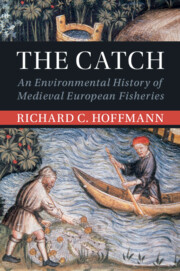Book contents
- The Catch
- Studies in Environment and History
- The Catch
- Copyright page
- Dedication
- Additional material
- Contents
- List of Figures
- List of Maps
- Preface and Acknowledgements
- Abbreviations Used in Notes and Bibliography
- Introduction
- 1 “Natural” Aquatic Ecosystems around Late Holocene Europe
- 2 Protein, Penance, and Prestige
- 3 Take and Eat
- 4 Master Artisans and Local Markets
- 5 Aquatic Systems under Stress, c. 1000–1350
- 6 Cultural Responses to Scarcities of Fish
- 7 Going beyond Natural Local Ecosystems, I
- 8 Going beyond Natural Local Ecosystems, II
- 9 Last Casts
- Appendix A Glossary of European Fishes Named in This Book
- References
- Index
5 - Aquatic Systems under Stress, c. 1000–1350
Published online by Cambridge University Press: 11 May 2023
- The Catch
- Studies in Environment and History
- The Catch
- Copyright page
- Dedication
- Additional material
- Contents
- List of Figures
- List of Maps
- Preface and Acknowledgements
- Abbreviations Used in Notes and Bibliography
- Introduction
- 1 “Natural” Aquatic Ecosystems around Late Holocene Europe
- 2 Protein, Penance, and Prestige
- 3 Take and Eat
- 4 Master Artisans and Local Markets
- 5 Aquatic Systems under Stress, c. 1000–1350
- 6 Cultural Responses to Scarcities of Fish
- 7 Going beyond Natural Local Ecosystems, I
- 8 Going beyond Natural Local Ecosystems, II
- 9 Last Casts
- Appendix A Glossary of European Fishes Named in This Book
- References
- Index
Summary
The high-medieval demographic and economic growth in which fishers and their customers shared had detectable environmental consequences. Prevailing agricultural practices plus increased human and other wastes damaged river systems and polluted both flowing and still waters. Contemporaries were aware of some such effects; others emerge only in modern scientific archaeology. Rulers and others blamed perceived declines in the quantity and quality of fish on overfishing. Present-day studies of long-running assemblages of fish remains detect local depletion of favoured varieties and shrinking average size of more common species. Some fishes (eel) and some fisheries (for herring) of previously limited importance increased their contribution to European diets. An exotic species, common carp, hitherto present in Europe only in the lower Danube, spread westwards into waters made warmer and siltier by human activities. In large thirteenth-century assemblages (but with regional variations), more accessible herring, eel, codfishes, and small cyprinids become dominant. Not all change had human origin; natural dynamics also played a role. High medieval centuries saw the crest, then decline, of climatic warming, with concomitant regional differences in precipitation, seasonality, riverine and estuarine hydrology, and even shifts in stratification and water chemistry of the Baltic. Changed habitats let heat-tolerant fishes spread west, while a herring-dominated regime in the Baltic peaked and slowly yielded to greater presence of cod. Knowingly or not, humans and animals had to adapt.
Keywords
- Type
- Chapter
- Information
- The CatchAn Environmental History of Medieval European Fisheries, pp. 183 - 230Publisher: Cambridge University PressPrint publication year: 2023



